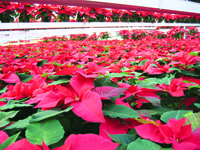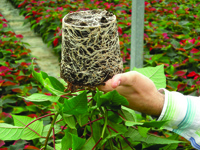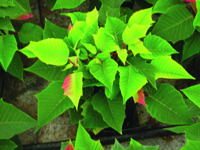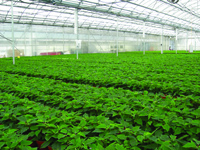
Measure twice, cut once!” … “Plans
are nothing; planning is everything.” … “Failing to plan is planning to
fail.” These are but a few of the frequently used quotes pointing to
the value of planning before starting any action.
 Measure twice, cut once!” … “Plans are nothing; planning is everything.” … “Failing to plan is planning to fail.” These are but a few of the frequently used quotes pointing to the value of planning before starting any action. When it comes to poinsettia crops, I have to agree they seem cliché but relevant. Advance planning makes a difference in how efficiently the crop is produced and ultimately influences profitability! Hopefully growers put more thought into ordering cuttings than just repeating the previous year’s order!
Measure twice, cut once!” … “Plans are nothing; planning is everything.” … “Failing to plan is planning to fail.” These are but a few of the frequently used quotes pointing to the value of planning before starting any action. When it comes to poinsettia crops, I have to agree they seem cliché but relevant. Advance planning makes a difference in how efficiently the crop is produced and ultimately influences profitability! Hopefully growers put more thought into ordering cuttings than just repeating the previous year’s order!
Advance Planning Activities that can happen as soon as the previous crop has been sold:
Start with a good analysis of the crop just completed – the absolute best time to look objectively at adjustments to solve problems is while the facts are still clear. What worked and what didn’t? What changes need to be made for next year?
The start date for cuttings is influenced by size of product forms to be grown. It does not make sense to transplant cuttings for an 8” to 10” pot on the same date as a 6.5” pot due to differences in finished heights required for each item.
 And as tempting as it is to consolidate shipments for ease of ordering, growers are better served to order based on the optimum production schedule for each form grown. Not only does this ensure each is getting the optimum schedule for growth, it also spreads the workload over a number of weeks and relieves some of the pressure to handle a large volume of work in such a short window of time. Most poinsettia breeding companies provide resources to assist growers develop production schedules based on their varieties; take advantage of these resources. At the Ecke website, go to www.ecke.com/html/tibs/tib_crop_schedule.html for help with developing production schedules appropriate for different product forms and markets.
And as tempting as it is to consolidate shipments for ease of ordering, growers are better served to order based on the optimum production schedule for each form grown. Not only does this ensure each is getting the optimum schedule for growth, it also spreads the workload over a number of weeks and relieves some of the pressure to handle a large volume of work in such a short window of time. Most poinsettia breeding companies provide resources to assist growers develop production schedules based on their varieties; take advantage of these resources. At the Ecke website, go to www.ecke.com/html/tibs/tib_crop_schedule.html for help with developing production schedules appropriate for different product forms and markets.
When preparing these schedules, there will be a range of adjustments needed based on vigour of specific varieties, production temperatures and other key variables. Be sure to factor these adjustments into the plan before placing orders for cuttings. Now is also a good time to plan for pots, soil and other supply needs while the numbers are fresh in your mind and in adequate time to assure delivery before the start of the crop!
Variety selection is another variable to consider when planning. With over 200 varieties commercially available today, growers are clearly not limited in their choice of which poinsettias to produce! But choosing effectively from the list of available varieties requires honest evaluation of which are best suited to a grower’s specific production.
Is the crop going to be sleeved, boxed and transported a significant distance to the retailer?
If so, varieties need to be durable and well suited for transportation.
Is stem breakage a factor to be solved? If so, varieties genetically resistant to stem breakage, such as ‘Prestige Early Red,’ ‘Prestige Red’ or ‘Prestige Maroon’ are ideal choices.
| |
| Poinsettia height tracking can assist growers in making good decisions regarding the application of PGRs as needed during production. |
‘V’-SHAPED STEM STRUCTURE BEST FOR HIGH DENSITY CROPPING
n Is the crop going to be grown at high density? If so, varieties that have upright ‘V’-shaped stem architecture are better suited to being grown with less space.
Is the crop going to be produced at cool temperatures? If so, varieties with earlier flowering response times and adequate vigour are best in order to be ready for sale early enough for most markets and still reach a salable size despite any delays and reduction in size resulting from a cooler growing environment.
These are all variables to be looked at before selecting which poinsettias to grow. For more information, check breeder websites. For Ecke varieties, for example, go to www.ecke.com/html/tibs/energy_efficient_poinsettia.htm.
Crop Preparation Activities that happen in the weeks leading up to the arrival of cuttings:
Before cuttings arrive there is a list of preparations needed to prevent delays in handling product and avoiding unnecessary problems during early stages of crop growth.
Sanitation: Clean greenhouses, tools and other supplies that will be used on the crop. By starting clean, it is easier to stay clean and use fewer chemicals to mitigate problems. In particular, eliminate weeds in or around the greenhouse to remove potential host sites supporting insects and/or diseases detrimental to the crop.
Anticipation: Know when cuttings will arrive so production staff is ready to handle them immediately. Companies like Ecke Ranch have introduced web-based shipment tracking capabilities (http://www.eckeglobal.com/EckeTraffic/login.aspx ) that allow growers to see where cuttings are at any time during transit and therefore anticipate when labour is needed. This website allows growers or brokers to access information from any computer on the status of an Ecke order by using the order number or PO number associated with the shipment.
 |
| Avoid nutritional deficiencies by monitoring fertility through soil and tissue analysis. |
THOROUGHLY INSPECT CUTTINGS WHEN RECEIVED
Inspection: No matter who the source of cuttings is, do not assume everything is clean! By taking time to thoroughly check cuttings upon their arrival, it is possible to minimize moving a new problem into the greenhouse. Train key staff to inspect plants prior to transplanting and be sure everyone handling cuttings knows what to be on the look out for. When problems are identified, isolate and use appropriate treatments to deal with the immediate situation and work with the supplier(s) to secure replacements and appropriate follow up to resolve the problem.
Preparation: Apply shade to greenhouse roofs or above the crop to mitigate heat and high light on young transplants. Minimizing stress to recently planted cuttings means they will establish and begin active growth faster than plants marginalized due to inappropriate conditions in the greenhouse.
Crop management activities once the poinsettia crop is on site and in process:
Growing good poinsettias requires daily attention to crop needs – it’s never over until the last plant is packed and delivered to the customer. From start to finish there are lots of adjustments to be made. Here are a few areas of particular focus.
Maintaining good cultural practices goes a long way to prevent most problems. When adequate space is provided for each plant grown and the crop is well managed for irrigation/fertilization, the risk for problems is reduced. In fact, issues such as stretch and stem breakage are minimized and many disease problems are prevented by creating conditions that are not favourable to the pathogen!
SCOUT REGULARLY DURING ALL CROP STAGES
Insect and disease management: The best way to avoid problems with either insects or diseases goes back to the basic principles of crop health management. Start clean (see sanitation and inspection above). Scout the crop regularly during all stages of production to identify when and where a problem establishes on plants. Be sure to consider all parts of the plant when looking for problems.
Inspect root systems regularly and work towards developing the healthiest roots possible. Check random plants in all areas of the crop to ensure all issues are identified early enough that recovery is possible. When inspecting, be on the lookout for insect pests like fungus gnat larvae, or the most common disease issues, including Pythium, Rhizoctonia and Phytophthora.
Inspect stems regularly for any evidence of damage or stem rot. Lesions near the soil line could be caused by Rhizoctonia, a problem generally seen early in the crop when plants are buried too deep or where removal of leaves or other wounds during transplant open the plant to infection. If found at later crop development stages, it is often the result of fungus gnat larvae feeding on the stem followed by infection by this pathogen.
While the roots and stems are the hardest plant systems when it comes to early detection, they have the potential to be the most significant problem areas for the crop to recover from.
Inspect leaves/bracts regularly for insects and/or disease infections. The most common insect problems still include whitefly and mites (two-spotted or lewisi types). The most common diseases to attack leaf tissue include botrytis and powdery mildew.
When problems are found, it is important to respond quickly and to use treatments appropriate to the problem. For online help diagnosing crop disorders, go to www.ecke.com/new1/poin/points_tech_diag_key.asp .
Height tracking is another important crop monitoring tool to help growers make decisions with the PGR programs. There is no better tool available than seeing how the plant is growing from one measurement date to the next and watching the trends in development. Because weather conditions are variable from one year to the next, it is not reasonable to depend on a schedule from a previous season for growth regulator treatments as an effective method of managing crop height. Ecke offers a free, web-based tracking program that growers can use from any computer capable of connecting to the Internet; the link for this program is www.ontarget.ecke.com .
Nutrition is another variable that is easy to monitor and track. Programs are available from labs like JR Peters with their PTS (Poinsettia Tracking System). While established growers usually have the nutritional management of the crop under fairly good control, it is important to remember each year brings subtle changes in water source quality, variety selection and other factors that can lead to problems not anticipated. A few simple tests at key stages of development can be cheap insurance for the value of this crop!
 |
| By paying attention to weather conditions and adjusting irrigation, fertilization and temperature management during production, crops can grow to their optimum potential. |
EVALUATE ENVIRONMENTAL CONDITIONS DAILY
Environmental management should be evaluated daily. Adjustments to day and night temperatures, light intensities and humidity are necessary to get the best results from any crop, not just poinsettias. Especially for growers trying out cool temperature growing as a method to save energy and costs, close attention to the environment is essential. This is where having good written and visual (photos) records from previous crops can be beneficial. Nothing confirms better if you are ahead or behind in development than referring back to records from previous seasons.
When growers have crop questions, help is available at www.eckeranchtechhelp.com/eve/ubb.x where the online bulletin board provides a forum to ask and answer crop culture questions 24/7! Timely response to any problem is the best way to prevent it from getting out of hand!
When it comes to getting off to a good start, there needs to be a total commitment to the planning process. By being true to this process, it is easier to adjust and modify the plan when things are not going as expected!
Jack Williams is a technical advisor for Ecke Ranch/Ecke Europe.
• jwilliams@eckeranch.com, or 760-944-4075
Print this page